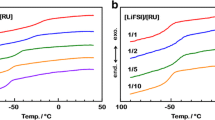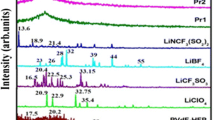Abstract
Polymer electrolytes based on vinyl ethers with various ethyleneoxy (EO) chain length (poly-1a (m = 3), poly-1b (m = 6), poly-1c (m = 10), and poly-1d (m = 23.5)) with lithium bis(trifluoromethanesulfonimide) (LiTFSI) were prepared, and effect of pendant EO chain length in the polymers on electrochemical and thermal properties was investigated. Glass transition temperature (T g) of all polymer electrolytes increased linearly with an increase in salt concentrations. Ionic conductivities of the polymer electrolytes increased with an increase in the pendant EO chain length of the polymers at the constant [Li]/[O] ratio, but in the polymer electrolyte of the poly-1d (m = 23.5) with the longest pendant EO chain length, ionic conductivity decreased in the low temperature range of −20 to 10 °C due to the crystallization of the pendant EO chain. The highest ionic conductivity, 1.23 × 10−4 S/cm at 30 °C, was obtained in the polymer electrolyte of the poly-1c (m = 10) with pendant EO chain length of 10 at the [Li]/[O] ratio of 1/20. It was found that the cross-linking of the polymer electrolyte, composed of poly-1c (m = 10) with LiTFSI at the [Li]/[O] ratio of 1/28, by electron beam (EB) irradiation may improve the mechanical property without affecting ionic conductivity, thermal property, and oxidation stability. Polymer electrolytes based on poly-1a (m = 3), poly-1b (m = 6), poly-1c (m = 10), and poly-1d (m = 23.5) and cross-linked polymer electrolytes were electrochemically stable until 4 V and thermally stable around 300 °C.






Similar content being viewed by others
References
Xu K (2004) Nonaqueous liquid electrolytes for lithium-based rechargeable batteries. Chem Rev 104:4303–4418
MacCallum JR, Vincent CA (1987) Polymer electrolyte reviews 1. Elsevier, London
MacCallum JR, Vincent CA (1989) Polymer electrolyte reviews 2. Elsevier, London
Scrosati B (1993) Applications of electroactive polymers. Chapman & Hall, London
Bruce PG (1995) Solid state electrochemistry. Cambridge Univ Press, Cambridge
Gray FM (1991) Solid polymer electrolytes: fundamentals and technological applications. VCH Publishers, New York
Gray FM (1997) Polymer electrolytes. The Royal Society of Chemistry, Cambridge
Liplowski J, Ross PN (1994) The electrochemistry of novel materials. VHC Publishers, New York
Croce F, Appetecchi GB, Persi L, Scrosati B (1998) Nanocomposite polymer electrolytes for lithium batteries. Nature 394:456–458
Nishimoto A, Watanabe M, Ikeda Y, Kojiya S (1998) High ionic conductivity of new polymer electrolytes based on high molecular weight polyether comb polymers. Electrochim Acta 43:1177–1184
Schaefer JL, Yanga DA, Archer LA (2013) High lithium transference number electrolytes via creation of 3-dimensional, charged, nanoporous network from dense functionalized nanoparticle composite. Chem Mater 25:834–839
Ping J, Pan Y, Pan H, Wu B, Zhou H, Shen Z, Fan XH (2015) High conductivity at high temperatures of lithium salt-doped amphiphilic alternating copolymer brush with rigid side chains. Macromolecules 48:592–599
Zardalidis G, Pipertzis A, Mountrichas G, Pispas S, Mezger M, Floudas G (2016) Effect of polymer architecture on the ionic conductivity. Densely grafted poly(ethylene oxide) brushes doped with LiTf. Macromolecules 49:2679–2687
Itoh T, Hirata N, Wen Z, Kubo M, Yamamoto O (2001) Polymer electrolytes based on hyperbranched polymers. J Power Sources 97–98:637–640
Tominaga Y, Izumi Y, Kwark GH, Asai S, Sumita H (2003) Effect of the supercritical carbon dioxide processing on ionic association and conduction in a crystalline poly(ethylene oxide)-LiCF3SO3 complex. Macromolecules 36:8766–8772
Itoh T, Gotoh S, Uno T, Kubo M (2007) Properties of the cross-linked composite polymer electrolytes using hyperbranched polymer with terminal acryloyl groups. J Power Sources 174:1167–1171
Chmielewski AG (2006) Worldwide developments in the field of radiation processing of materials in the down of 21st century. Nukureonika 51(Suppl 1):s3–s9
Evans J, Vincent CA, Bruce PG (1987) Electrochemical measurement of transference numbers in polymer electrolytes. Polymer 28:2324–2328
Bruce PG, Evans CA (1987) Steady state current flow in solid binary electrolyte cells. J Electroanal Chem 225:1–17
Allcock HZ, Kellam EC (2003) The synthesis and applications of novel alkoxy/oligoethyleneoxy substituted polyphosphazenes as solid polymer electrolytes. Solid State Ionics 156:401–414
Matsumoto M, Uno T, Kubo M, Itoh T (2011) Electrochemical and thermal properties of polymer electrolytes based on the random and triblock copolymers of poly(ethylene oxide) with poly(propylene oxide). J Mater Sci Eng A 1:607–615
Vogel H (1921) The law of the reaction between the viscosity of liquids and the temperature. Phys Z 22:645–646
Tamman G, Hesse W (1926) The dependence of viscosity upon the temperature of supercooled liquids. Z Anorg Allg Chem 156:245–247
Fulcher GS (1925) Analysis recent measurements of viscosity of glasses. J Am Ceram Soc 8:339–355
Timachova K, Watanabe H, Balsara NP (2015) Effect of Molecular weight and salt concentration on ionic transport and the transference number in polymer electrolytes. Macromolecules 48:7882–7888
Author information
Authors and Affiliations
Corresponding author
Rights and permissions
About this article
Cite this article
Itoh, T., Fujita, K., Uno, T. et al. Polymer electrolytes based on vinyl ethers with various EO chain length and their polymer electrolytes cross-linked by electron beam irradiation. Ionics 23, 257–264 (2017). https://doi.org/10.1007/s11581-016-1815-x
Received:
Revised:
Accepted:
Published:
Issue Date:
DOI: https://doi.org/10.1007/s11581-016-1815-x




